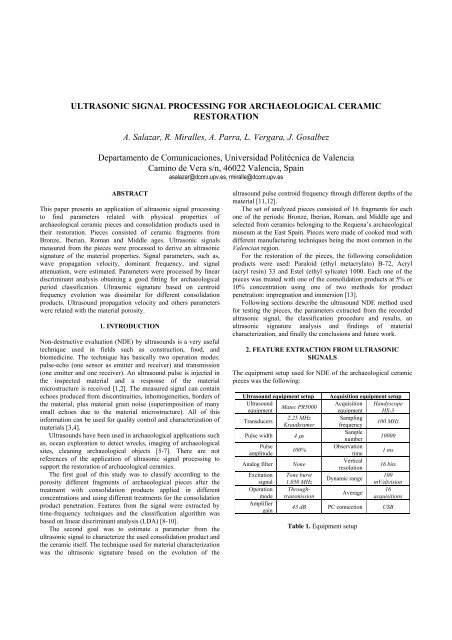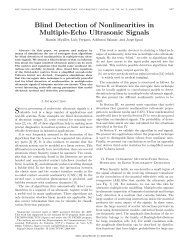ULTRASONIC SIGNAL PROCESSING FOR ARCHAEOLOGICAL ...
ULTRASONIC SIGNAL PROCESSING FOR ARCHAEOLOGICAL ...
ULTRASONIC SIGNAL PROCESSING FOR ARCHAEOLOGICAL ...
Create successful ePaper yourself
Turn your PDF publications into a flip-book with our unique Google optimized e-Paper software.
<strong>ULTRASONIC</strong> <strong>SIGNAL</strong> <strong>PROCESSING</strong> <strong>FOR</strong> <strong>ARCHAEOLOGICAL</strong> CERAMICRESTORATIONA. Salazar, R. Miralles, A. Parra, L. Vergara, J. GosalbezDepartamento de Comunicaciones, Universidad Politécnica de ValenciaCamino de Vera s/n, 46022 Valencia, Spainasalazar@dcom.upv.es, rmiralle@dcom.upv.esABSTRACTThis paper presents an application of ultrasonic signal processingto find parameters related with physical properties ofarchaeological ceramic pieces and consolidation products used intheir restoration. Pieces consisted of ceramic fragments fromBronze, Iberian, Roman and Middle ages. Ultrasonic signalsmeasured from the pieces were processed to derive an ultrasonicsignature of the material properties. Signal parameters, such as,wave propagation velocity, dominant frequency, and signalattenuation, were estimated. Parameters were processed by lineardiscriminant analysis obtaining a good fitting for archaeologicalperiod classification. Ultrasonic signature based on centroidfrequency evolution was dissimilar for different consolidationproducts. Ultrasound propagation velocity and others parameterswere related with the material porosity.1. INTRODUCTIONNon-destructive evaluation (NDE) by ultrasounds is a very usefultechnique used in fields such as construction, food, andbiomedicine. The technique has basically two operation modes:pulse-echo (one sensor as emitter and receiver) and transmission(one emitter and one receiver). An ultrasound pulse is injected inthe inspected material and a response of the materialmicrostructure is received [1,2]. The measured signal can containechoes produced from discontinuities, inhomogeneities, borders ofthe material, plus material grain noise (superimposition of manysmall echoes due to the material microstructure). All of thisinformation can be used for quality control and characterization ofmaterials [3,4].Ultrasounds have been used in archaeological applications suchas, ocean exploration to detect wrecks, imaging of archaeologicalsites, cleaning archaeological objects [5-7]. There are notreferences of the application of ultrasonic signal processing tosupport the restoration of archaeological ceramics.The first goal of this study was to classify according to theporosity different fragments of archaeological pieces after thetreatment with consolidation products applied in differentconcentrations and using different treatments for the consolidationproduct penetration. Features from the signal were extracted bytime-frequency techniques and the classification algorithm wasbased on linear discriminant analysis (LDA) [8-10].The second goal was to estimate a parameter from theultrasonic signal to characterize the used consolidation product andthe ceramic itself. The technique used for material characterizationwas the ultrasonic signature based on the evolution of theultrasound pulse centroid frequency through different depths of thematerial [11,12].The set of analyzed pieces consisted of 16 fragments for eachone of the periods: Bronze, Iberian, Roman, and Middle age andselected from ceramics belonging to the Requena’s archaeologicalmuseum at the East Spain. Pieces were made of cooked mud withdifferent manufacturing techniques being the most common in theValencian region.For the restoration of the pieces, the following consolidationproducts were used: Paraloid (ethyl metacrylato) B-72, Acryl(acryl resin) 33 and Estel (ethyl sylicate) 1000. Each one of thepieces was treated with one of the consolidation products at 5% or10% concentration using one of two methods for productpenetration: impregnation and immersion [13].Following sections describe the ultrasound NDE method usedfor testing the pieces, the parameters extracted from the recordedultrasonic signal, the classification procedure and results, anultrasonic signature analysis and findings of materialcharacterization, and finally the conclusions and future work.2. FEATURE EXTRACTION FROM <strong>ULTRASONIC</strong><strong>SIGNAL</strong>SThe equipment setup used for NDE of the archaeological ceramicpieces was the following:Ultrasound equipment setupUltrasoundequipmentMatec PR5000Transducers2.25 MHzKrautkramerPulse width 4 µsPulseamplitudeAnalog filterExcitationsignalOperationmodeAmplifiergain100%NoneTone burst1.050 MHzThroughtransmissionAcquisition equipment setupAcquisition Handyscopeequipment HS-3Samplingfrequency100 MHzSamplenumber10000Observationtime1 msVerticalresolution16 bitsDynamic range100mV/divisionAverage16acquisitions43 dB PC connection USBTable 1. Equipment setup
Acquisition equipmentUltrasound equipmentRoma nMiddle a geEmitterAdaptorCeramicpieceFig 1. Equipment and detail of ultrasonic testingReceiverPieces were measured one time by transmission mode, using arubber adaptor, see Figure 1. This coupling method was selecteddue to good ultrasonic transmission and to be innocuous for thepieces, after trying with methods such as immersion and directcontact. This latter (contact by gel) offers a very good coupling butthe time for measuring is very short to avoid gel absorption by thepiece.Figure 2a shows some of the pieces and Figure 2b shows theultrasonic signals extracted from those pieces. In order to test thesensitivity of the ultrasonic signals to changes of material physicalproperties from different ages, various parameters for classifyingwere calculated from the signals. The ultrasonic parameters -features- and the formulas used for their calculation are in Table 2,where x(t)is the recorded signal and X ( f , t)is the Short TimeFourier Transform. The first 6 parameters were used forclassification and the last one –centroid frequency– was used toanalyze the signature of the material properties.UltrasonicparameterPropagationvelocityPrincipalfrequencyPrincipalfrequencyattenuation(dB)Signal powerTotal signalattenuationAttenuationcurve initialvalue (dB)CentroidfrequencyxiFormulapiece thicknessv =ultrasound time of flightf max = max { X ( f , t)f−tβi{ X ( f , t)·Notch ( f )}−1i ( f , t)= TFfilter,fix ( f , t)= Ae⇒ At _ F Re son = βT2∫= 0x(t)dtP _ TotalT−βtx(t)= AeAten _ Total = β−βtx(t)= AePo = 10log(A)f 2∫f ⋅ X ( f , t)dff1fc ( t)=f 2∫f1X ( f , t)dfTable 2. Features space for classification and material signatureiIberianBronze age2a. Some analyzed pieces 2b. Ultrasonic signalsFig 2. Ultrasonic signals measured from archaeological ceramicsE[fmax] (kHz)Principal frequency attenuation140012001000800600400Low Porosity Medium P.RomanMiddle ageHigh PorosityIberianBronzeage200700 800 900 1000 1100 1200 1300 1400 1500Propagation velocity [m/s]Fig 3. Propagation velocity vs. Principal frequency350300250200150100Low Por osity Medium P.RomanMiddleageHigh PorosityIberianBronzeage50700 800 900 1000 1100 120 0 1300 1400 1500Propagation velocity [m/s]Fig 4. Propagation velocity vs. Principal frequency attenuation3. STATISTICAL CLASSIFICATIONFigures 3 and 4 are scatterplot diagrams of the ceramic pieces setusing two features: propagation velocity vs. principal frequencyand propagation velocity vs. principal frequency attenuation. Inthese bidimensional feature subspaces the ceramic pieces wereclassified according to age with a high percentage of success withfew misclassified pieces.
Archaeological period81.25 75 81.25 56.25100 75 75 75100 56.25 62.5 81.25Bronze age Iberian Middle age RomandistanceLinearQuadraticFig 5. Classification results of archaeological ceramicsMahalanobisIn addition, Figures 3 and 4 show two values of propagationvelocity around 920 and 1040 m/s, which can be used as thresholdsto determine porosity differences for the ceramics from differentperiods. The resulting clusters were highly correlated with a prioriknowledge on the kind of ceramic porosity.Precision of the previous bidimensional classification wasimproved adding more features to the classification space thatallows increasing the separation of the disjoint subspaces or classesthat the pieces belong to. For this study the complete classificationspace was composed by 6 features and the cases were 64. The total384 data were processed by a classifier based on LDA with fourdefined classes corresponding to each one of the ceramicarchaeological periods, i.e., Bronze, Iberian, Roman and Middleage.Classification procedure followed a supervised scheme with 5steps: i.) Label the database cases with the known archaeologicalperiod, ii.) Select a case of the database, iii.) Estimate anarchaeological period for the selected case by LDA algorithmusing the remaining cases as training data, iv.) Repeat steps ii andiii until the end of the cases, and v.) Calculate the percentage ofsuccess for classification results.Basically the classifier works calculating distances between thecases (pieces) and separating them in disjoint classificationsubspaces. Then various distances were tried (linear, quadratic,and mahalanobis), obtaining high average values of success in theclassification (linear: 73.44%, quadratic: 81.25%, mahalanobis:75%) to determine the historic period of the piece, see Figure 5.Classification of the archaeological ceramics from ultrasonicsignal parameters worked well, independently of the treatmentapplied to the pieces with different consolidation products. Besidesof classifying the pieces according to the archaeological period,others classifications were tried, such as, classifying byarchaeological period and consolidation product and classifying byarchaeological period and consolidation method.Both results for those classifications were low successpercentages due to the few number of cases for the number ofclasses, 12 and 8 respectively. Classifying only by consolidationproduct or method has no sense in the present application becausethe features of the ultrasonic signals separate the pieces firstlyaccording to their archaeological period instead of theconsolidation product or method.4. <strong>ULTRASONIC</strong> SIGNATURE ANALYSISAdditionally to the classification procedure, an analysis of thephysical characteristics of the pieces treated by consolidationproducts was made by calculating an ultrasonic signature. Theultrasonic signature consists in the evolution curve of the centralfrequency of the injected ultrasonic pulse while it propagatesinside the material.Centroid Frequency [Hz]7 x 10665432Paraloid 10%Paraloid 5%Sylicate1Acryl 5%Acryl 10%00 0.5 1 1.5 2 2.5 3 3.5 4 4.5Time [s]x 10 -5Fig 6. Ultrasonic signature by centroid frequency evolution inMiddle Age pieces for the different consolidation productsThe centroid frequency evolution is related to the way thedifferent frequency components of the pulse spectrumprogressively are attenuated. In general, the frequencies attenuatein a different way causing spectrum variations and consequentlythe central frequency of the pulse varies. These variations areinherent to the physical properties of the material and can enableits characterization. The technique to obtain the ultrasonicsignature is made by a non-stationary analysis of the grain noise atdifferent penetration depths of the pulse and it has two steps:estimation of the pulse spectrum and estimation of the centralfrequency of the spectrum.Grain noise is generated by the superposition of multipleechoes caused by the material microstructure, when an ultrasonicpulse with a suitable frequency is injected in the material. Grainnoise can be modelled stochastically and spectral techniques canbe applied to the model to extract parameters and correlate themwith material physical properties, allowing its characterization. Aclassic method to analyze the dependence of the attenuation withthe frequency is measuring the significant frequency through thegrain noise spectrum. The instantaneous centroid frequency, theone corresponding to the maximum energy, and the resonancefrequency feature certain variation with depth due to thedependence with the frequency attenuation [14].Figure 6 shows the evolution of the centroid frequency in thesignal record time for the middle age ceramics consolidated by theimpregnation method. This 5-piece set features a dissimilarultrasonic signature for each case, i.e., the signature of theconsolidation product (acryl, paraloid, sylicate) used in theceramic can be discriminated. This result of high correlationbetween the ultrasonic signature and the material properties wasobtained in some subsets of the analyzed pieces.All the values of centroid frequency evaluated at the materialdepth corresponding to 15 µs of the signal record, for the ceramicsconsolidated by the impregnation method, are shown in Figure 7.A correlation between the centroid frequency values and thearchaeological periods exists. This correlation is related with thematerial porosity property as we found in classification results.Data of Figure 7 exhibits a variance of the centroid frequencyfor each period due to the different consolidation products andtheir concentration applied in the restoration process.
Universidad Politécnica de Valencia, for providing the samples foranalysis.7 x 106 PeriodCentroid Frequency at 15 µs6543210Middle age Roman Iberian Bronze ageFig 7. Centroid frequency evolution at 15 µs of the signal recordfor pieces treated with impregnation methodData variance in Figure 7 allows distinguishing theconsolidation products for Middle and Bronze ages as we showedin Figure 6, but for the Roman and Iberian periods there are certainoverlapping between their centroid frequency values. This lattermake difficult to separate the consolidation products using only thecentroid frequency as ultrasonic signature.Both for the impregnation and the immersion methods ofconsolidation, the curve traced through the mean values of thecentroid frequency of the pieces for the different periods growsmonotonically with the ceramic age.5. CONCLUSIONS AND FUTURE WORKUtilization of ultrasonic signal processing in archaeologicalceramic pieces has been validated by statistical classification andultrasonic signature techniques. Parameters extracted from therecorded ultrasonic signals were related with the porosity physicalproperty of the analyzed pieces. These parameters are theultrasound propagation velocity and the centroid frequency.Classification of archaeological ceramics from ultrasonicparameters worked well, independently of the consolidationtreatment applied on the pieces. Six features were used, but theycan be extended or modified in order to improve the classificationresults.The evolution of the centroid frequency as a material signaturefeatured different behaviour for different kind of consolidationproducts used in archaeological ceramic restoration. This resultwas found in some subsets of the analyzed pieces, such as themiddle and Bronze Age pieces treated by impregnation. It has tobe pursued to find others parameters to characterize theconsolidation product for restoration of the analyzed pieces.Findings of this work open an important research line in thearchaeological ceramic restoration. Results have to be refined withmore extended studies with the purpose of obtaining a tool basedon ultrasonic signal processing for optimization of theconsolidation products and methods in the restoration process.ACKNOWLEDGEMENTSThis work has been supported by Spanish Administration undergrant TEC 2005-01820 and Universidad Politécnica de Valenciaunder interdisciplinary grant 2004-0900. We thank Departamentode Conservación y Restauración de Bienes Culturales,6. REFERENCES[1] J. Krautkrämer, Ultrasonic Testing of Materials, Springer, 4thedition, Berlin, 1990.[2] J.D. Cheeke, Fundamentals and Applications of UltrasonicWaves, CRC Press LLC, USA, 2002.[3] L. Vergara, J. Gosálbez, J. Fuente, R. Miralles, I. Bosch, A.Salazar, A. López, and L. Domínguez, “Ultrasonic Nondestructivetesting on Marble Block Rocks”, Materials Evaluation, AmericanSociety for Non-destructive Testing, v. 62, n. 1, pp. 73-78, 2004.[4] L. Vergara, et al., “NDE Ultrasonic Methods to Characterizethe Porosity of Mortar”, NDT&E International, Elsevier, v. 34 n.8, pp. 557-562, 2001.[5] R. Cribbs, and F. Saleh, “An Ultrasonic Based System Used forNon-destructive Imaging of Archaeological Sites”, in: Informaticaed Egittologia all’inizio degli anni ‘90. A cura di FrancescoTiradritti, Roma, Bulzoni Editore, pp. 97-108, 1996.[6] A. Murray, M. F. Mecklenburg, C. M. Fortenko, and R. E.Green, "Detection of Delaminations in Art Objects Using Air-Coupled Ultrasound", Proceedings of Materials Issues in Art andArchaeology III, pp. 371-378, San Francisco CA, 1992.[7] W.I. Sellers, “Ultrasonic Cave Mapping”, Journal ofArchaeological Science, Elsevier, n. 25, pp. 867-873, 1998.[8] L. Cohen, Time-frequency analysis, Englewood Cliffs, PrenticeHall, 1995.[9] R. Duda, P.E. Hart, and D.G. Stork, Pattern Classification,Wiley-Interscience, 2nd edition, 2000.[10] B.D. Ripley, Recognition and Neural Networks, CambridgeUniversity Press, 1997.[11] L. Vergara, J. Gosalbez, R. Miralles, and I. Bosch, “OnEstimating the Center Frequency of Ultrasonic Pulses”,Ultrasonics, Elsevier, v. 42, pp. 813-818, 2004.[12] L. Vergara, J. Gosalbez, J.V. Fuente, R. Miralles, and I.Bosch, “Measurement of cement porosity by centroid frequencyprofiles of ultrasonic grain noise”, Signal Processing, Elsevier, v.84, n. 12, pp. :2315-2324, 2004.[13] B. Carrascosa, and M. Lastras, “Socarrats”, Restoration &Rehabilitation, América Ibérica, n. 100, 2005.[14] L. Vergara, J.V. Fuente, J. Gosalbez, R. Miralles, and I.Bosch, “Processing of Ultrasonic Grain Noise Signals for theEstimation of Depth- and Frequency-Dependent Attenuation”,Measurement Science and Technology, Institute of Physics, v. 14,n. 7, pp. 1018-1024, 2003.






